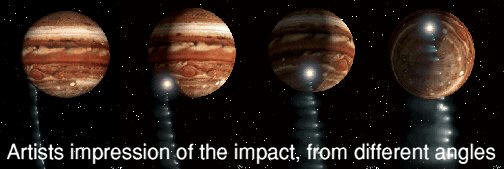
Jupiter

Jupiter is the fifth planet from the Sun, and is easily the largest planet in the solar system. It is orbited by sixteen moons, only four of which have significant size: Ganymede, Callisto, Io, and Europa. These are the Galilean Satellites, discovered by Galileo Galilei (1564-1642) in 1610!
Jupiter is referred to as a 'gas giant', meaning that it is nearly all atmosphere, with a relatively small solid core. This very deep atmosphere is composed mainly of hydrogen and helium, with the upper clouds being formed from droplets of ammonia. The visible surface of the atmosphere is very vivid, showing distinct features and weather systems. One such feature is the Great Red Spot, which has been identified as a whirling storm, rotating clockwise once every 12 days. Clearly visible, too, are bands, representing different currents occurring in the cool Jovian atmosphere. These can be seen to rotate, with the polar regions moving more slowly than the equatorial regions.
A Faint Ring Jupiter has a faint ring system, not visible from Earth. It was first discovered when the Voyager probes flew by, photographing it in the shadow behind the planet.

Inside a Giant The planet's size creates enormous pressure at its core, and, as such, produces large amounts of radiation and heat. The core temperature may be as high as 30,000 degC. The radiation belts extend far beyond the planet into space, and provide a lethal environment for spacefaring craft that venture too close. The planet also produces a powerful magnetic field. It is interesting to note that, had the planet been somewhat more massive than it is, it would be classified as a star. There would have been enough pressure, due to gravity, to start nuclear fusion in its core. It would have shone with its own light, giving us a solar system with two stars (a commonly observed occurrence in other parts of the Galaxy). Had this happened, life could not have existed on Earth.
Comet Collision On the 18th July, 1994, Jupiter was hit by 19 fragments of comet Shoemaker-Levy that it had pulled apart the year before.

Despite striking the far side of the planet, as seen from Earth, the impacts caused explosion after explosion - and it was to be recorded by every telescope on Earth, the H.S.T. in orbit, and Galileo probe, still 18 months away from the great planet.
The collisions were more powerful than atomic bombs, and left impact bruises twice the size of the Earth in Jupiter's atmosphere!
Probes to Jupiter Close up details of Jupiter and its moons have been received by various probes launched since 1972.
The first to arrive was Pioneer 10 in 1973, followed by Pioneer 11 and Voyagers 1 and 2 in 1979.
In December 1995, NASA's Galileo probe finally arrived, beginning a two year tour of the Jovian system, and launching its own probe into the turbulent atmosphere. In 1997, it began an extended mission concentrating on Europa. The probe is named after Galileo Galilei.
Jupiters Moons Jupiter has such a stong gravitational field that it produces gaps in the Asteroid belt. No asteroids have ever been found with an orbital period that is 1/3, 1/2, 2/5 or 3/7 that of Jupiter. This effect is similar to the Cassini division in Saturn's rings.